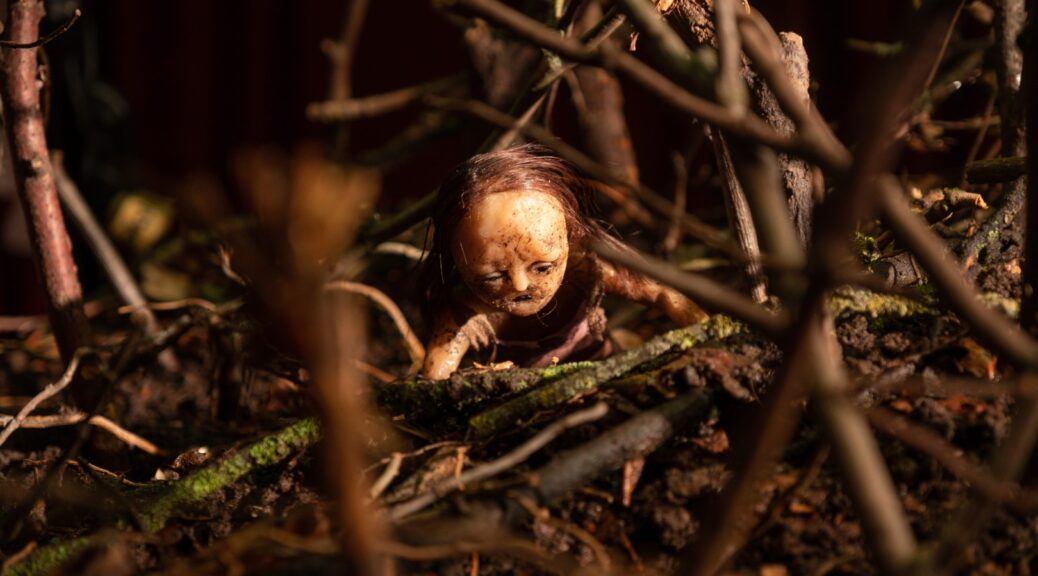Muse and madness, art and commerce duke it out in a slew of films that mine the depths of the artistic nature. We welcome author LCW Allingham, whose dark novella Muse looks at the darker side of art, to join us as we use a little fuzzy math to share our favorite horror movies about artists.
6. Devil’s Candy (2015)
Ethan Embry plays Jesse Hellman, struggling metalhead painter who, with his wife and pre-teen daughter, just bought a bargain of a house out in the Texas sticks. Why so cheap? Amityville shit.
Jesse’s a metalhead and a painter and writer/director Sean Byrne (The Loved Ones) mines the dark artist nature for all its worth in a film that benefits from a rockin soundtrack, and a slew of good performances (shout at the devil to Pruitt Taylor Vince).
A convoluted storyline that mixes supernatural with serial killer is a bit of a drawback. But clocking in at under 90 minutes, Devil’s Candy is a tight little rocker. The lyrics are familiar, but the riffs still kick ass.
5. House of Wax (1953)
An update of the 1933 Mystery of the Wax Museum and precursor to Wax Works (and, of course, the 2005 loose remake), this Vincent Price classic tells a campy fun tale that also resembles a lot of Price’s other films.
An elegant artist turned disfigured madman, Price’s Henry Jarrod creates masterful wax figures of historical horrors. But there’s a secret behind the realistic look!
Yes, you totally know what that secret is, but that diminishes the fun of this film not one tiny bit. Price is fun, Carolyn Jones is a hoot, Charles Bronson’s a wild piece of casting. And the whole bit of insanity boils down to the fact that an artist who wants to earn a living has to sacrifice their integrity.
4. A Bucket of Blood (1959)
Roger Corman’s riff on House of Wax sets this dark comedy in LA’s beanik community of the late Fifties. Dick Miller’s perfect as a dimwitted janitor who accidentally becomes the next big thing by turning a cat, then a police officer, then other people he kills into sculptures.
The more he makes, the more famous he becomes, and the more he rationalizes the murders. Corman’s tone is cynical but fun, working from Charles B. Griffith, who’d also write Corman’s Little Shop of Horrors. It’s a weird little gem of a film.
3. Stopmotion (2024)
There will be moments when you’re watching Robert Morgan’s macabre vision Stopmotion that you’ll think you see the twists as they’re coming. That’s a trick. Morgan, writing with Robin King, assumes you’ll catch the handful of common horror twists, but he knows that you won’t predict the real story unfolding.
Aisling Franciosi (The Nightingale) is Ella. She’d like to make her own stop-motion animated film, but instead she’s helping her mom finish hers. Ella’s domineering mother Suzanne (Stella Gonet, very stern) is a legend in the field, and she makes Ella feel as if she has no stories of her own to tell.
Stopmotion delivers a trippy, uncomfortable, and deeply felt tale of a struggling artist. This is a descent into madness horror of sorts, but it’s also the story of an artist coming to a realization about what scares her most.
2. Mandy (2018)
Writer/director Panos Cosmatos’s hallucinogenic fever dream of social, political and pop-culture subtexts layered with good old, blood-soaked revenge, Mandy throws enough visionary strangeness on the screen to dwarf even Nicolas Cage in full freakout mode.
Like Cosmatos’s 2010 debut Beyond the Black Rainbow, Mandy is both formally daring and wildly borrowed. While Black Rainbow, also set in 1983, shines with the antiseptic aesthetic of Cronenberg or Kubrick, Mandy feels more like something snatched from a Dio album cover.
When his artist girlfriend Mandy (Andrea Riseborough) is kidnapped and killed by a cult, Red (Cage) enacts a bloody quest for revenge.
Or is it all the story Mandy’s painting?
Either way, it is as badass as it can be.
1. Candyman (2021)
For Nia DaCosta’s sequel to the 1992 classic, we go back to Chicago’s now-gentrified Cabrini Green housing project with up-and-coming artist Anthony McCoy (Yahya Abdul-Mateen II), whose works have taken a very dark turn since he learned of the Candyman legend from laundromat manager William Burke (Colman Domingo).
DaCosta’s savvy storytelling is angry without being self-righteous. Great horror often holds a mirror to society, and DaCosta works mirrors into nearly every single scene in the film. Her grasp of the visual here is stunning—macabre, horrifying, and elegant. She takes cues from the art world her tale populates, unveiling truly artful bloodletting and framing sequences with grotesque but undeniable beauty. It’s hard to believe this is only her second feature.
By the time a brilliant coda of sadly familiar shadow puppet stories runs alongside the closing credits, there’s more than enough reason for horror fans to rejoice and…#telleveryone.
